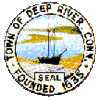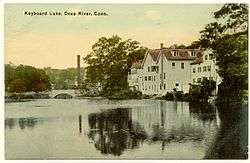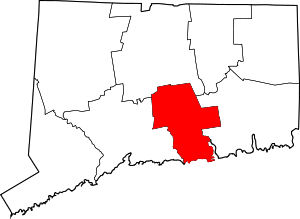Deep River, Connecticut
Deep River is a town in Middlesex County, Connecticut, United States. The population was 4,629 at the 2010 census. The town center is also designated by the U.S. Census Bureau as a census-designated place (CDP). Deep River is part of what the locals call the "Tri-town Area" made up of Deep River, Chester, and Essex, Connecticut.
Deep River, Connecticut | |
|---|---|
 Seal | |
Location within Middlesex County, Connecticut | |
| Coordinates: 41°22′03″N 72°27′50″W | |
| Country | |
| U.S. state | |
| County | Middlesex |
| Metropolitan area | Hartford |
| Established | 1635 |
| Name changed | 1947 |
| Named for | A Deep River referring to the Connecticut River |
| Government | |
| • Type | Selectman-town meeting |
| • First selectman | Angus L. McDonald, Jr. |
| • Selectman | Duane Gates |
| • Selectman | David N. Oliveria (R) |
| Area | |
| • Total | 14.2 sq mi (36.8 km2) |
| • Land | 13.6 sq mi (35.1 km2) |
| • Water | 0.6 sq mi (1.6 km2) |
| Elevation | 131 ft (40 m) |
| Population (2010) | |
| • Total | 4,629 |
| • Density | 330/sq mi (130/km2) |
| Time zone | UTC-5 (Eastern) |
| • Summer (DST) | UTC-4 (Eastern) |
| ZIP code | 06417, 06419 |
| Area code(s) | 860/959 |
| FIPS code | 09-19130 |
| GNIS feature ID | 0213417 |
| Website | www |
Geography
According to the United States Census Bureau, the town has a total area of 14.2 square miles (37 km2), of which 13.6 square miles (35 km2) is land and 0.6 square miles (1.6 km2) (4.30%) is water. The CDP has a total area of 2.7 square miles (7.0 km2), of which 4.38% is water.
Principal communities
- Deep River center
- Winthrop
History
Saybrook Colony formally joined Connecticut in 1644. The portion of the original colony east of the Connecticut River was set off as a separate town in 1665. The site of the present village of Deep River was said to have been owned by John, Nathaniel, and Philip Kirtland in 1723.[1] The village of Winthrop was said to have been settled by Baptists as early as 1729.[1] In the early to mid-19th century, various portions of Saybrook broke off as separate towns, starting from Chester in 1836 to Old Saybrook in 1854. In 1947, the town of Saybrook changed its name to "Deep River", matching the name of the town center village.
From 1961 until 1996, Deep River Convalescent Home was in operation on West Elm Street in Deep River. The building itself still remains, but has deteriorated considerably since being closed.
First Selectman Richard "Smitty" Smith, who had been in office since 1989, died of a heart attack on March 25, 2016. He was serving his 13th term (Over 26 years) as the Town's First Selectman when he died. He was subsequently replaced as First Selectman by Angus McDonald Jr, who had previously served at Second Selectman.
Towns created from Saybrook Colony

Saybrook Colony, along the mouth of the Connecticut River, was one of the early settlements in the area. Several towns broke off and incorporated separately over the course of time. The towns which were created from parts of Saybrook Colony are listed below.
Ivory
From 1840 to around 1940, the U.S. was the world's biggest buyer of ivory and most of that ivory went to Deep River. Phineas Pratt developed an ivory lathe and eventually Deep River became known as "the queen of the valley" due to wealth from the ivory industry.[2] The rival Comstock, Cheney & Company was established in nearby Ivoryton in the 1860s.
Points of interest
These sites in town are on the National Register of Historic Places:
- Deep River Freight Station – 152 River St.; since December 21, 1994
- Deep River Town Hall – Connecticut Route 80 and Connecticut Route 154; since January 1, 1976
- Doris (Sailing yacht) – Connecticut River off River Rd.; located there when NRHP-listed, May 31, 1984
- Pratt, Read and Company Factory Complex – Main St. between Bridge and Spring Sts. and 5 Bridge St.; since August 30, 1984
- The grave of XYZ – Mysterious bank robber's grave w/ "XYZ" initials. Fountain Hill Cemetery. Knock thrice.[3]
- Mount Saint John – 135 Kirtland St.
Events
Every year on the third Saturday in July, Deep River hosts the Deep River Ancient Muster, the largest one day gathering of fife and drum corps in the United States.[4]
Demographics
| Historical population | |||
|---|---|---|---|
| Census | Pop. | %± | |
| 1820 | 4,165 | — | |
| 1840 | 3,417 | — | |
| 1850 | 2,904 | −15.0% | |
| 1860 | 1,213 | −58.2% | |
| 1870 | 1,267 | 4.5% | |
| 1880 | 1,362 | 7.5% | |
| 1890 | 1,484 | 9.0% | |
| 1900 | 1,634 | 10.1% | |
| 1910 | 1,907 | 16.7% | |
| 1920 | 2,325 | 21.9% | |
| 1930 | 2,381 | 2.4% | |
| 1940 | 2,332 | −2.1% | |
| 1950 | 2,570 | 10.2% | |
| 1960 | 2,968 | 15.5% | |
| 1970 | 3,690 | 24.3% | |
| 1980 | 3,994 | 8.2% | |
| 1990 | 4,332 | 8.5% | |
| 2000 | 4,610 | 6.4% | |
| 2010 | 4,629 | 0.4% | |
| Est. 2014 | 4,571 | [5] | −1.3% |
| U.S. Decennial Census[6] | |||
As of the census[7] of 2000, there were 4,610 people, 1,824 households, and 1,262 families living in the town. The population density was 340.1 people per square mile (131.4/km2). There were 1,910 housing units at an average density of 140.9 per square mile (54.4/km2). The racial makeup of the town was 94.56% White, 2.41% African American, 0.04% Native American, 0.80% Asian, 0.07% Pacific Islander, 1.04% from other races, and 1.08% from two or more races. Hispanic or Latino of any race were 2.95% of the population.
There were 1,824 households, out of which 30.2% had children under the age of 18 living with them, 56.6% were married couples living together, 9.1% had a female householder with no husband present, and 30.8% were non-families. 24.0% of all households were made up of individuals, and 8.7% had someone living alone who was 65 years of age or older. The average household size was 2.46 and the average family size was 2.93.
In the town, the population was spread out, with 24.3% under the age of 18, 5.4% from 18 to 24, 30.6% from 25 to 44, 26.3% from 45 to 64, and 13.3% who were 65 years of age or older. The median age was 39 years. For every 100 females, there were 98.5 males. For every 100 females age 18 and over, there were 96.6 males.
The median income for a household in the town was $51,677, and the median income for a family was $62,260. Males had a median income of $46,268 versus $32,454 for females. The per capita income for the town was $32,604. About 3.9% of families and 5.1% of the population were below the poverty line, including 4.7% of those under age 18 and 7.8% of those age 65 or over.
CDP
As of the census of 2000, there were 2,470 people, 1,023 households, and 652 families living in the CDP. The population density was 943.2 inhabitants per square mile (364.0/km2). There were 1,077 housing units at an average density of 411.3 per square mile (158.7/km2). The racial makeup of the CDP was 92.19% White, 3.72% African American, 0.08% Native American, 0.61% Asian, 0.04% Pacific Islander, 1.94% from other races, and 1.42% from two or more races. Hispanic or Latino of any race were 3.81% of the population.
There were 1,023 households, out of which 26.7% had children under the age of 18 living with them, 50.0% were married couples living together, 10.6% had a female householder with no husband present, and 36.2% were non-families. 29.2% of all households were made up of individuals, and 9.8% had someone living alone who was 65 years of age or older. The average household size was 2.30 and the average family size was 2.84.
In the CDP the population was spread out, with 23.1% under the age of 18, 6.3% from 18 to 24, 31.6% from 25 to 44, 24.9% from 45 to 64, and 14.0% who were 65 years of age or older. The median age was 38 years. For every 100 females, there were 101.1 males. For every 100 females age 18 and over, there were 95.9 males.
The median income for a household in the CDP was $44,680, and the median income for a family was $51,685. Males had a median income of $42,958 versus $30,880 for females. The per capita income for the CDP was $27,261. About 3.9% of families and 5.5% of the population were below the poverty line, including 7.0% of those under age 18 and 3.5% of those age 65 or over.
| Voter Registration and Party Enrollment as of October 25, 2005[8] | |||||
|---|---|---|---|---|---|
| Party | Active Voters | Inactive Voters | Total Voters | Percentage | |
| Democratic | 909 | 33 | 942 | 29.17% | |
| Republican | 651 | 31 | 682 | 21.12% | |
| Unaffiliated | 1,527 | 71 | 1,598 | 49.49% | |
| Minor Parties | 7 | 0 | 7 | 0.22% | |
| Total | 3,049 | 135 | 3,229 | 100% | |
Education
The towns of Deep River, Chester, and Essex make up Regional School District #4.[9] Deep River is home to Deep River Elementary School, serving grades K-6. John Winthrop Middle School and Valley Regional High School, serve students for grades 7-8 and 9-12, and are located on Warsaw Street and Kelsey Hill Road, respectively. Additionally, the Connecticut Transition Academy at Mount Saint John which serves students for grades from elementary to high school which is located on Kirtland Street and across the river from Gillette Castle State Park, respectively.
Transportation
The Estuary Transit District provides public transportation throughout Deep River and the surrounding towns through its 9 Town Transit Service. Services include connections to the Old Saybrook Train Station, served by Amtrak and Shoreline East railroads.
Notable people
- Elizabeth Jarvis Colt, wife of firearms manufacturer Samuel Colt
- Benjamin Hyde Edgerton, surveyor, politician
- Mysterious Dave Mather, Wild West gunfighter
- Gretchen Mol, actress
- Alpheus S. Williams, lawyer, judge, journalist, U.S. Congressman, and a Union general in the American Civil War
References
- J.B. Beers and Co., History of Middlesex County
- Joyce, Christopher (18 August 2014). "Elephant Slaughter, African Slavery And America's Pianos". NPR. Retrieved 29 August 2014.
- "The Grave of XYZ". Atlas Obscura. Retrieved 2018-04-23.
- Davis, Caryn B. (July 2, 2013). "Fife & Drum Corps". American Profile. Athlon Media Group. Retrieved March 20, 2019.
In the last 50 years, Lamay has never missed the Deep River Ancient Muster, the largest gathering of fife and drums corps in the United States.
- "Annual Estimates of the Resident Population for Incorporated Places: April 1, 2010 to July 1, 2014". Archived from the original on May 23, 2015. Retrieved June 4, 2015.
- "Census of Population and Housing". Census.gov. Retrieved June 4, 2015.
- "U.S. Census website". United States Census Bureau. Retrieved 2008-01-31.
- "Registration and Party Enrollment Statistics as of October 25, 2005" (PDF). Connecticut Secretary of State. Archived from the original (PDF) on 2006-09-23. Retrieved 2006-10-02.
- http://www.reg4.k12.ct.us/
External links

- Town government Web site
- Central Regional Tourism District

